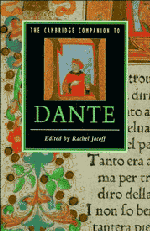Book contents
- Frontmatter
- 1 Life of Dante
- 2 Dante and the lyric past
- 3 Approaching the Vita nuova
- 4 The unfinished author
- 5 Dante and the empire
- 6 Dante and Florence
- 7 Dante and the classical poets
- 8 Dante and the Bible
- 9 The theology of Dante
- 10 A poetics of chaos and harmony
- 11 Introduction to Inferno
- 12 Introduction to Purgatorio
- 13 "Shadowy prefaces"
- 14 Dante and his commentators
- 15 Dante in English
- Further reading
- Index
12 - Introduction to Purgatorio
Published online by Cambridge University Press: 28 May 2006
- Frontmatter
- 1 Life of Dante
- 2 Dante and the lyric past
- 3 Approaching the Vita nuova
- 4 The unfinished author
- 5 Dante and the empire
- 6 Dante and Florence
- 7 Dante and the classical poets
- 8 Dante and the Bible
- 9 The theology of Dante
- 10 A poetics of chaos and harmony
- 11 Introduction to Inferno
- 12 Introduction to Purgatorio
- 13 "Shadowy prefaces"
- 14 Dante and his commentators
- 15 Dante in English
- Further reading
- Index
Summary
OF THE THREE otherworldly kingdoms which the Divina Commedia represents, Purgatory is Dante's most original creation. Hell and Paradise were already well established places within the medieval imagination. Each possessed a standard set of topographic and iconographic attributes which, accrued in the course of many centuries of patristic tradition, rendered them instantly recognizable to prince and pauper alike. Hell was a dark, subterranean place where eternal torments were administered by demons under the guidance of Satan, the ruler of the underworld. Paradise was Hell's positive counterpart: a luminous celestial palace where eternal blessings were administered by the angels under the guidance of God, the emperor of the universe. In both cases the author of the Commedia felt called upon less to alter preexisting traditions, than to extend and systematize them: establishing, for instance, a much more precise hierarchy of the degrees of damnation or blessedness endured or enjoyed by souls in the afterlife; and finding a place for specifically Christian categories of error, like heresy, within an Aristotelian moral system.
- Type
- Chapter
- Information
- The Cambridge Companion to Dante , pp. 192 - 207Publisher: Cambridge University PressPrint publication year: 1993
- 1
- Cited by

